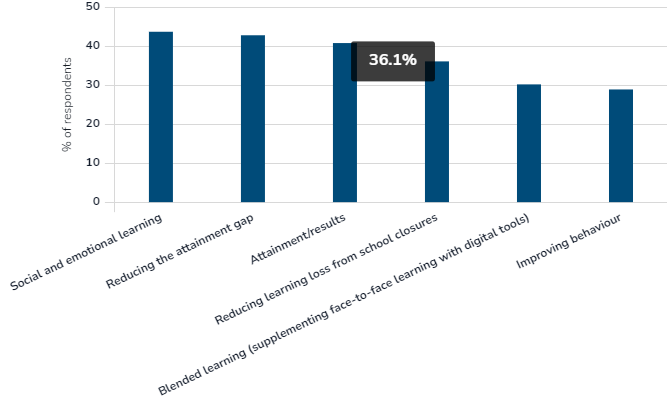Getting students involved in social-emotional learning has been one of the most focused areas of education for the last decade. Social-emotional learning, also known as “SEL,” is the process by which students learn and apply the knowledge, skills, and attitude necessary to forge positive identities, control emotions, demonstrate empathy for others, and maintain healthy societal relationships.
Conversely, with technological revolutions emerging, many institutions are focusing on leveraging technology in social-emotional learning.
The way of teaching is shifted towards hybrid learning; teachers are now more aligned toward education based on research demonstrating the significance of social skills and emotional intelligence in determining success.
The accessibility of advanced technologies is one of the key factors encouraging social-emotional learning (SEL) use in the classroom. Technology fills the gap in successfully implementing SEL activities in a world where learning is dominated by podcasts, videos, game-based learning, and instant-response applications.
Technology In Social-Emotional Learning (SEL): The Relationship Booster

As per the sources, 44% of educators say social and emotional learning is the key strategic priority.
Social-emotional learning aims to build meaningful relationships for children. It was a branch off the instructional tree when it initially gained popularity and was essentially its own thing. But now, the technological revolution brings social-emotional learning into teaching strategies.
Students who participate in SEL activities gain the ability to think differently, critically and independently. Incorporating SEL ideas into instruction is only the start; educators may incorporate concepts like social awareness and authenticity. Social-emotional learning may go to new heights by using EdTech.
Read more: Importance of child psychology courses in India
It Helps Students Express Emotions in Different Social Areas
There is a deep relationship between technology and Social-emotional learning because when students utilize digital tools in practical ways, they may produce more learning experiences.
When connecting with students’ emotions, technology creates the learning material or learning ways more realistically. Additionally, learners typically exhibit higher levels of curiosity and enthusiasm.
Some people find it challenging to communicate their thoughts, whether for physiological or psychological reasons and to employ different tech tools that might assist them.
Assists In developing soft skills and social-emotional learning
In recent years, it has become increasingly important for students to acquire soft skills through SEL activities. Before this, teachers had been heavily emphasizing teaching technical skills like coding.
It is simpler to monitor the growth of complex abilities; on the other, it is equally crucial for students to develop soft skills.
And the data revealed that kids might benefit from developing both hard and soft abilities since they are closely related.
Social-emotional learning enables students to manage their workloads and seek their classmates or friends for assistance when they need it.
How Can Technology Improve Social and Emotional Learning?
Students may gain other pertinent abilities through social-emotional learning experiences, even if they are not frequently connected with social-emotional learning and social and emotional skills.
These encompass abilities like perseverance, exercising empathy, problem-solving, and reworking studies to succeed where others have failed.
The capacity to persevere through setbacks may be developed in many ways, especially when educational technology is involved.
The introduction of EdTech can increase the significance of SEL and aid students in developing essential 21st-century skills.
Advantages of technology and Social-Emotional Learning
Giving students the freedom to design their own unique learning experiences is one of the most significant advantages of adopting education technology in social-emotional development.
Schools generally display higher levels of engagement and eventually achieve better outcomes when they study subjects they are interested in and genuinely want to learn.
Specialized techniques also aid the assessment of social-emotional learning. To learn more about how children are progressing with SEL skill development and their general attitudes, teachers can utilize a variety of approaches.
To teach students how they can improve, teachers might use formative evaluations or gather additional information that helps students and teachers design particular courses.
Monitoring student development with technology
Technology allows for higher degrees of tailored learning for children in social-emotional learning. Using technological tools allows them to remain in their comfort zones essentially.
By doing this, it is made sure that kids are neither learning too quickly nor becoming overly bored. Performance frequently improves with increasing levels of comfort.
The greater availability of student performance data may also be beneficial if instructors access a tracking platform.
Besides, social-emotional learning in technology gives kids more agency. They frequently have the opportunity to experiment with different approaches to problem-solving and have the freedom to make their judgments as they take on greater levels of leadership in their learning.
Read more: Top 10 healthy parenting tips
How Can Technology Strengthen Social-Emotional Skills?
In addition to significantly impacting education, education technology is getting more advanced and potent.
Therefore, while the current workforce status necessitates that children obtain expertise with high-tech tools, school officials and parents also want to guarantee that they are developing social and emotional skills since they are crucial.
It won’t be enough to provide students with computer tools and encourage them to collaborate with classmates.
Students require assistance with new technologies, mainly when used in conjunction with social-emotional development.
The cornerstone of social-emotional learning in several areas
Teaching public speaking is one instance of integrating technology into social-emotional development.
To make the best out of the students, teachers can teach them to control their emotions, as many kids experience anxiety while speaking in front of an audience. Teachers can give their students a mic or a laptop to communicate with the whole class. This makes students more at ease while participating in class discussions or responding to queries.
Using Robotics To Enhance Social-Emotional Learning
Students, especially those with social or language difficulties, can utilize various educational robotics tools to communicate by programming the robot to pronounce particular words or carry out specific activities that convey their feelings.
Several robots are highly developed humanoid excellent for autistic students. It provides a calming influence and genuinely aids their increased comfort with speaking.




